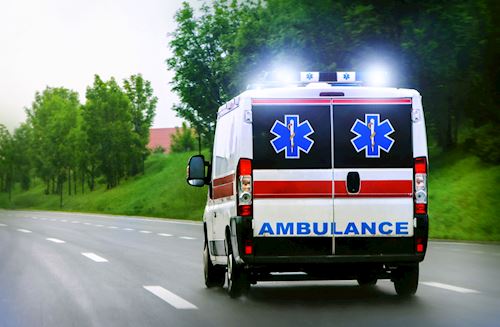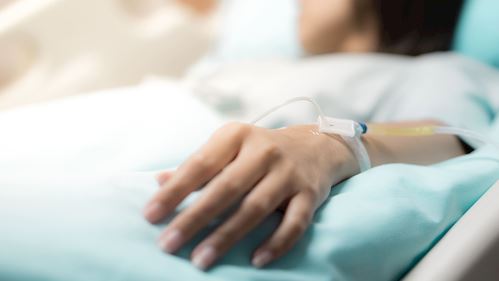 1. Anna burned about forty percent of her body in a kitchen grease fire. Third-degree burns were present on her right shoulder, upper anterior right arm, and part of the anterior trunk. Second-degree burns with blistering were present on the remaining burn areas. Anna experienced subsequent shock with tachypnea, tachycardia, and low blood pressure.
1. Anna burned about forty percent of her body in a kitchen grease fire. Third-degree burns were present on her right shoulder, upper anterior right arm, and part of the anterior trunk. Second-degree burns with blistering were present on the remaining burn areas. Anna experienced subsequent shock with tachypnea, tachycardia, and low blood pressure.
2. Symptoms of shock include increased heart rate, increased respiration rate, pale cool skin, and possibly falling blood pressure. While a first or second-degree burn is painful, third-degree burns destroy sensory neurons and are therefore without pain. Coughing or difficulty breathing may indicate damage to the lungs from smoke inhalation. Core body temperatures are typically high because the body's thermostat in the hypothalamus is reset.
3. The amount of body surface area burned can be estimated using the rule of nines. The severity of the burn is assessed by redness only (first degree), blistering (second degree), or marble-white to mahogany or dry charred skin (third degree).
More information about the extent of internal damage from the burn is assessed using a CBC, Chemistry panel, Urinalysis, Carboxyhemoglobin, and Chest X-ray. In this patient, an elevated WBC count with an elevation of neutrophils indicated widespread inflammation from the burn. An elevated Hct was due to loss of plasma and fluids. Glucose levels are slightly elevated from the patient's stress response. Extremely elevated levels of creatine kinase indicate muscle breakdown. High levels of BUN indicate kidney damage. Total proteins levels are low from a loss of blood plasma and proteins.
The Chest X-ray indicated no lung damage. Low levels of carboxyhemoglobin along with the chest x-ray results, indicated there was little smoke inhalation in this burn.
4. Shock is treated by laying the patient down and raising and supporting the legs. The patient should be kept warm and the patient's airway and breathing should be constantly monitored. CPR should be performed if the patient is not breathing.
Major concerns with a burn patient are the loss of fluids, infection (from loss of the protective barrier of the skin), and lung damage from smoke inhalation. In this patient, edema in the face and neck was obstructing the airway. Mechanical ventilation was used to open the airway and breathe for Anna until the swelling subsides. IV fluids were used to treat the fluid loss. Urinary output was carefully monitored so that enough fluids are given to replace fluid loss. Silver, antimicrobial dressings guard against infection until the patient is stable enough for surgery. Skin debridement prepares the area for skin grafting which will replace the lost skin barrier.
A nasogastric tube is used for enteral feedings. Caloric intake must be greatly increased (as much as 5000 calories/day) to counteract the high metabolic rate induced by a burn).
5. There are approximately 450,000 burn injuries that receive medical treatment each year in the United States (American Burn Association, 2013). The amount of deaths from smoke inhalation is reported as 3,400/year with 40,000 hospitalizations each year from burn-related injuries.
The prognosis of a burn patient depends on the extent and severity of the burn. The very young and the very old also have a more difficult time recovering from a major burn. First and some second-degree burns may heal within days to weeks. Deep second-degree burn and third-degree burns take weeks to months to heal and usually cause scarring. Most of these burns require skin grafts. A burn that involves more than 90% of the total body surface (more than 60% in an older person), is usually fatal.
6. Burn prevention and fire safety tips are discussed in this link. Most of the suggestions are common sense. In Anna's case, if she had realized the proper way to put out a grease fire, she could have prevented the explosion. When the bacon grease started to smoke, she should have removed the pan from the stove. The depth of the frying pan should have been double the amount of grease. If she had 1 inch of grease, the frying pan should have been at least 2 inches deep. She could have used a screen to cover the pan to reduce the chance of splatters. Water should never be used to extinguish a grease fire. Anna could have covered the pan with a metal lid, used baking soda to extinguish the flame, or used a Class B dry chemical fire extinguisher. A fire extinguisher will contaminate the kitchen but it's better than burning up the house!
 7. Many healthcare professionals worked together to rescue Anna, treat her burn, and help her regain a productive life. Emergency rescue personnel including emergency medical technicians (EMT's), Paramedics, and Firefighters treated Anna for shock, started IV fluids, made sure the fire was extinguished and transported Anna to a burn facility. Burn personnel, including physicians and nurses, helped stabilize Anna. A respiratory therapist intubated Anna and started her on mechanical ventilation. Medical laboratory scientists were responsible for performing and reporting all of the laboratory tests. A radiology technician took the chest x-ray. A dietician was instrumental in monitoring Anna's diet and made sure she had the correct nutrients to maintain her heightened metabolic state. Skin grafting can be performed by either a general trauma surgeon or by a plastic surgeon. Facial burns would more typically be repaired by a plastic surgeon. An occupational therapist helped Anna regain the skills needed to function in her home and work environment. Anna worked with a team of mental health professionals, including a psychiatrist and social workers, that helped Anna learn to cope and fully function as a recovering burn patient.
7. Many healthcare professionals worked together to rescue Anna, treat her burn, and help her regain a productive life. Emergency rescue personnel including emergency medical technicians (EMT's), Paramedics, and Firefighters treated Anna for shock, started IV fluids, made sure the fire was extinguished and transported Anna to a burn facility. Burn personnel, including physicians and nurses, helped stabilize Anna. A respiratory therapist intubated Anna and started her on mechanical ventilation. Medical laboratory scientists were responsible for performing and reporting all of the laboratory tests. A radiology technician took the chest x-ray. A dietician was instrumental in monitoring Anna's diet and made sure she had the correct nutrients to maintain her heightened metabolic state. Skin grafting can be performed by either a general trauma surgeon or by a plastic surgeon. Facial burns would more typically be repaired by a plastic surgeon. An occupational therapist helped Anna regain the skills needed to function in her home and work environment. Anna worked with a team of mental health professionals, including a psychiatrist and social workers, that helped Anna learn to cope and fully function as a recovering burn patient.
